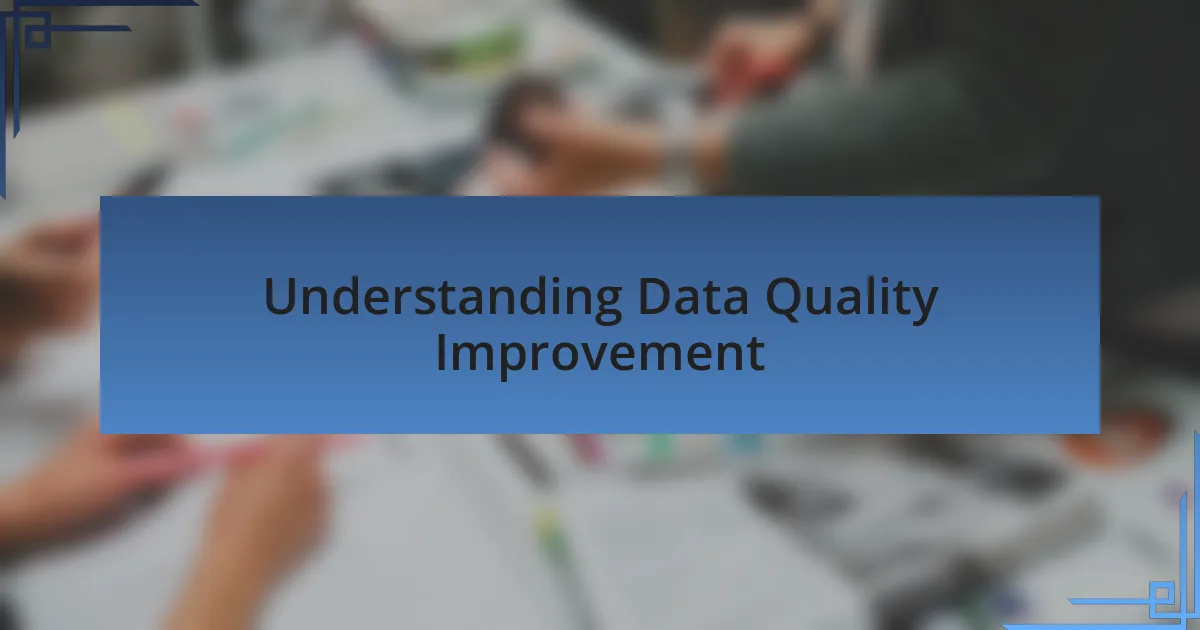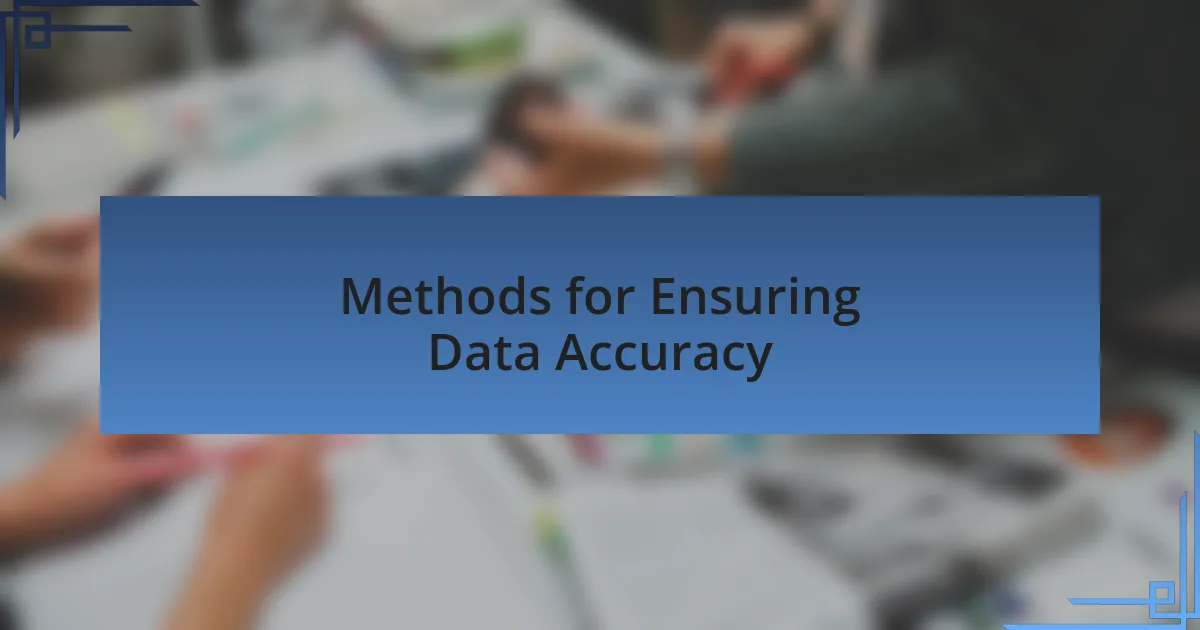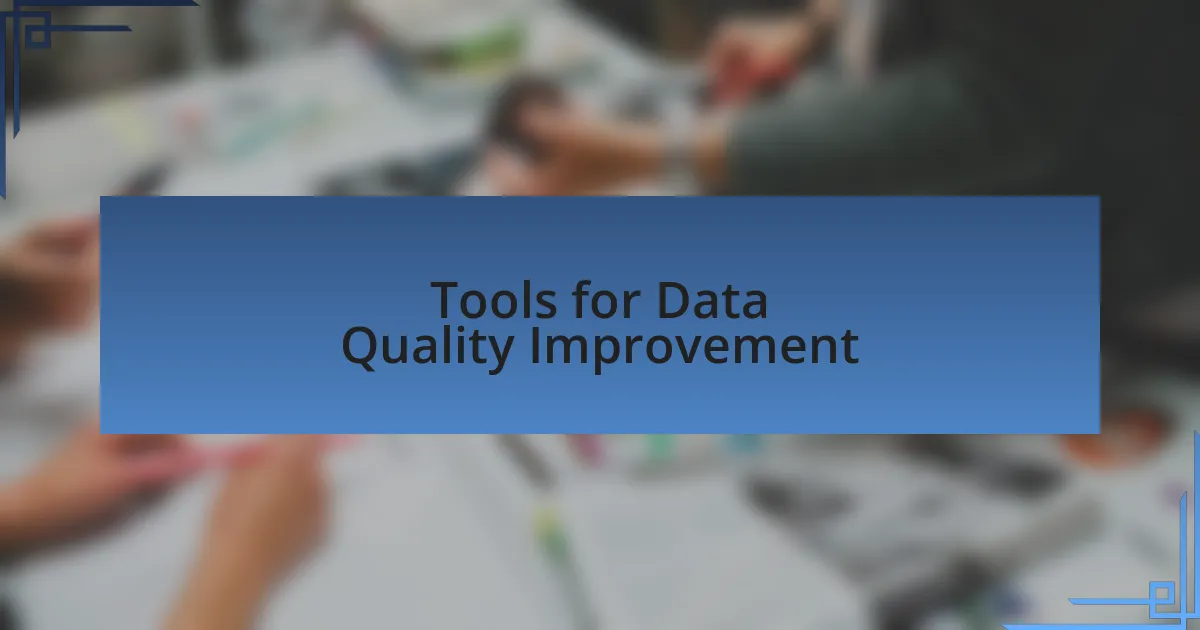Key takeaways:
- Data quality is essential for effective digital strategies, impacting marketing success and resource allocation.
- Common issues include data duplication, outdated information, and inconsistent formats, which can disrupt analysis and communication.
- Regular data audits and clear validation processes are crucial for maintaining data accuracy and accountability within teams.
- Tools like data cleansing software and visualization platforms enhance data quality, enabling better decision-making and strategy development.

Understanding Data Quality Improvement
Data quality improvement is a critical aspect of any effective digital strategy. I remember a time when I underestimated the impact of poor data quality; it led to a marketing campaign that completely missed the target audience. Have you ever experienced a disconnect between your data and the results? It’s a frustrating realization that can easily occur when data is incomplete or inaccurate.
When I delve into data quality, I focus on key dimensions like accuracy, completeness, and consistency. I often think about how these factors are like the foundation of a house—without a solid base, everything built on top can quickly crumble. For example, if I find a simple error in email addresses, I know it can lead to missed opportunities and wasted resources, prompting me to invest in tools that enhance data validation processes.
In my experience, fostering a culture that prioritizes data quality within a team is vital. It’s not just about processes; it’s about encouraging everyone to see data as a valuable asset. How often do we ask ourselves if our data reflects reality? When every team member recognizes the importance of maintaining high-quality data, the overall efficiency and effectiveness of our marketing efforts dramatically improve.

Common Data Quality Issues
When I think about common data quality issues, one that often comes to mind is data duplication. I’ve seen firsthand how multiple entries for the same contact can confuse campaign tracking and skew reporting. It’s like trying to navigate with two different maps; both may point you in the right direction, but the conflicting information can lead to chaos.
Another issue that frequently arises is outdated information. I recall a project where we relied on a list of leads that hadn’t been refreshed in months. The disappointment of receiving bounce-back emails when reaching out was palpable. It made me question the effectiveness of our outreach strategy. Updating data should be a regular practice—after all, if our contacts change jobs or locations but we don’t adapt, we’re essentially speaking into a void.
Then there’s the challenge of inconsistent data formats. Whether it’s variations in date formats or differing terminologies for the same product, I’ve often had to address these kinds of discrepancies. Just recently, I encountered an instance where one campaign reported sales in dollars while another reported in euros. Such inconsistency not only complicates analysis but can also distort the narrative we aim to communicate with stakeholders. How can we make informed decisions if the information we have can’t align?

Methods for Ensuring Data Accuracy
Ensuring data accuracy starts with establishing clear validation processes. For instance, I’ve implemented automatic checks that flag discrepancies as soon as data is entered. This proactive approach not only catches errors early but also fosters a culture of accountability. After all, how often have you found an error only after a report was generated?
Another effective method is regular data audits. I remember conducting an audit for a client and discovering that nearly 30% of their contact list was outdated. The satisfaction of presenting clean, accurate data not only increased their confidence but also significantly improved their campaign targeting. Regular reviews help in identifying trends and areas of concern before they spiral out of control.
Finally, training team members on the importance of data integrity can make a world of difference. I once hosted a workshop where we explored case studies on data failures. The collective “aha” moments during that session really drove home the point that everyone plays a role in maintaining accurate data. Why not empower your team with the knowledge to recognize and rectify potential issues before they escalate?

Tools for Data Quality Improvement
One of the pivotal tools I’ve found useful for data quality improvement is data cleansing software. When I first started using a tool like Talend, I was amazed at how quickly it identified duplicates in our database. The rush of relief was palpable—no one wants to encounter a messy dataset when preparing for a major campaign. Have you ever felt the weight lift off your shoulders when you know that your data is clean and ready to go?
Another handy resource is data visualization tools like Tableau. These tools not only present data clearly but also highlight discrepancies in a visual format, which I find incredibly impactful. In one project, I used Tableau to showcase our sales pipeline, revealing outliers that were empowering our decision-making process. Wouldn’t you agree that a well-structured visual can sometimes reveal what numbers alone cannot?
Lastly, incorporating advanced analytics platforms can significantly enhance data quality. After implementing Google Data Studio for a client’s reporting, I noticed that the insights gained sparked engaging discussions among team members about data accuracy and its implications. The excitement in those meetings reminded me that data quality isn’t just a backend concern; it directly influences strategy and creativity. Isn’t it fascinating how the right tools can ignite collective enthusiasm for data?